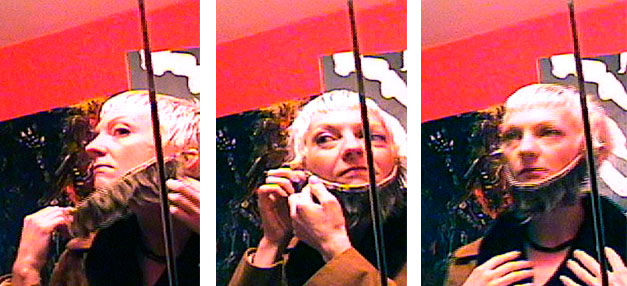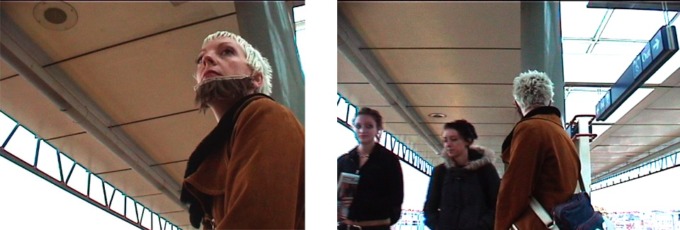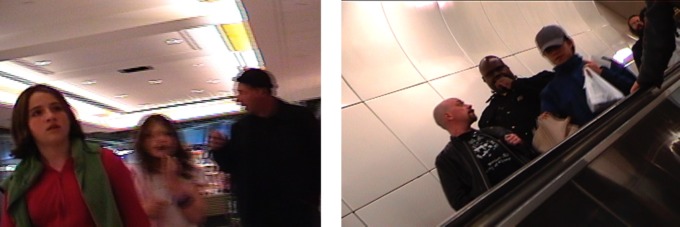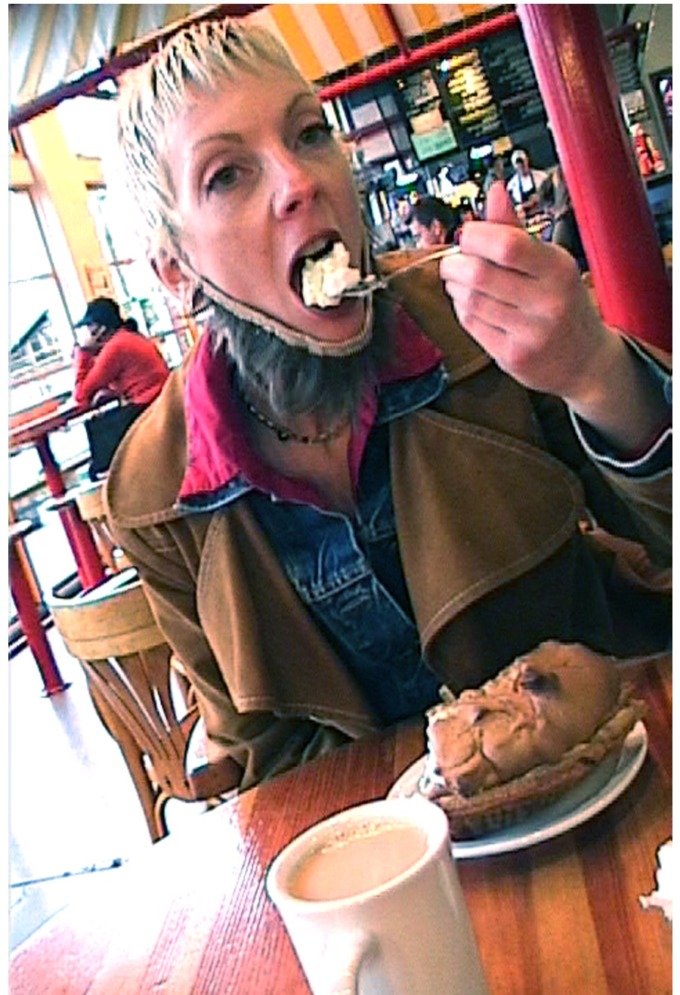The Bearding (Performance 2005)
Me in a ridiculously fake beard trying to make a point…
The idea for The Beard surfaced in 1994 amidst a trend of men sporting facial hair – literally sporting, as the trend was apparently brought about by a male superstition tied to hockey playoffs. I have since discovered that the official name for this type of beard is simply a “playoff-beard” – and that not shaving during the playoff season is directly linked to whether your team will win.
Facial hair was everywhere that year. Not being a fan of hockey, I thought it would be amusing (if somewhat facetious) to sport some constructed facial hair of my own.
The concept was brought forward within my circle of artist friends and the title Jody Wants a Goatee was coined. Being involved with various other things that were More Important, the goatee claimed its place in the back of my brain with the rest of the Ideas That Get Spoken of But Never Made.
Years passed and one day while I was shaving the hair off of my partner Stephen’s head I was quite taken with the beautiful, feather-like swatches of hair that were left lying on my kitchen floor. I collected the pieces carefully and put them aside. Later, when Stephen went out to do errands, I sewed the swatches of hair, layered in rows, onto a piece of discarded pantyhose. Five years after its conception, The Beard was born. When Stephen returned from his errands, I told him I had something to show him. I made him sit down and close his eyes. I put The Beard on.
The Beard received a favourable review and it claimed a place of honour on my studio wall – but although I would model it for visitors and friends, I didn’t have a space for it in my studio practice that it could occupy on more than a passive level (I was more interested in cross-species dressing than cross-gender dressing at the time) and eventually it got packed away. Ten years after its conception, and five years after its birth, The Beard was activated in a Public Gender Project.
Now…in order to give context to this performance I feel I need to digress a bit into some acadamia to set the stage…
Most people know the definition of beard as a noun defining the “hair of man’s lower face (excluding whiskers and moustache)”. What many folk may not know is that beard is also a verb meaning “to oppose openly or defy”. A beard is also the female companion of a gay man who wishes to be socially perceived as straight, his beard accessory making him appear more masculine.
I have discovered that the name of the style of beard I created is called the “chin-strap”. How appropriate it is that my symbol of male-ness is named a chin-strap. My chin-strap strap-on. My strap-on phallus. It should be noted that I am not, by far, the first woman to wear a strap-on to display male status or power. Hatshepsut, the first female ruler of Egypt on record, is depicted as wearing “the royal male nemes headdress and the pharaoh’s ceremonial beard” (Kleiner, 62). Hatshepsut’s adoption of male attributes of power is “consistent with the queen’s formal assumption of the title of king, and with the many inscriptions that address her as a man [his Highness]” (62).
Bearded ladies are abundant in myth, religion, and fiction. Robertson Davies recounts the tale of Saint Wilgefortis (Virgo-Fortis = Strong Virgin) – “sought by girls who wanted to get rid of disagreeable suitors” (Davies, 142) – in his novel Fifth Business:
…she was reputed to have been the daughter of a Portuguese king, himself a pagan, who had betrothed her to the King of Sicily; but she was a Christian and had made a vow of virginity, and when she prayed for assistance in keeping it, she miraculously grew a heavy beard; the Sicilian king refused to have her…(Davies, 142-3).
Did Saint Wilgefortis manage to avert a man’s desire – and therefore his power of the gaze – with her acquisition of male power, the possession of facial hair?
My beard is made from the head of a male – the significance of this is not lost on me. Akin to those who believe in the potency that will be personally attained by ingesting the innards and other body parts of rare animal species, I gain virility and power from the procuring of the man-hair for my beard. In The Beard I am Delilah having gone one step further: I am wearing the hair I have cut off my man, I am claiming the power of Samson as my own.
The timing of the Public Gender Project (fall) posed some logistic difficulties. In order for the project to work, it was important that the viewers were not able to connect what they were witnessing to an external reason; they must see a woman who is wearing an obviously fake beard for no discernible reason whatsoever. If it is done too early in September, people may identify the bearding as a university initiation or hazing gag. If it is done in the middle of October, people may connect it to pilgrims and Thanksgiving. Even worse, if it is performed late in October or early November, it will be connected to Hallowe’en, and its impact will be weakened considerably. Putting the project in action anywhere near the 11th of November may have been misconstrued as a sign of disrespect to our veterans. With all of this in mind, chose the first weekend in October for activating The Beard.
In order to keep focused I set strict parameters. It was important to me to not be perceived as a woman trying to be a man (full drag). I did not want to be a man – I wanted to see what it was like to be a woman with a beard – and to experience how people would perceive an otherwise feminine being wearing the facial hair of a man.
Documentation, whenever possible, was done by digital recording in a discreet, but open, manner. The time limit was approximately one tapes’ length (approx. 60 minutes of footage). I wore the beard in the following public spaces: on transit (bus and Skytrain), traveling through Pacific Centre Mall (downtown Vancouver), through Granville Island Market, as a customer in Starbuck’s. The Beard was worn continuously from the time a left my studio, until I returned home.
In no way was I physically threatening or aggressive. The goal was to be as unassuming as possible: to be seen in public places exerting quiet controversy in the form of providing a Zen Moment to those people who choose to see. I did not approach people, but allowed people to approach me. I answered questions truthfully and politely to anyone who had the balls to ask.
My prognosis for how people would react was this: a few people might stare/laugh/try to interact with me verbally. I figured most people would freak out and pretend I didn’t exist and hope to God that I don’t say anything or try in any way to interact with them: “Please, God, oh please, do not let the crazy lady with a beard sit down beside me!”. I assumed they would probably try to peek at me covertly when they think I am not looking, but that if I tried to make eye contact they would look away, embarrassed to be caught staring. In that respect, I anticipated the power of the beard to be that of averting the gaze (because I am no longer Other, but something different, abnormal; no longer an object). I wondered if The Beard would give me an inverse power, that of a woman possessing the gaze – the privilege to look but not be looked at?
This is, in fact, what occurred. The performance certainly shed light for me on what it is to be perceived as outside the norm. It is interesting to note that while not all of the threatened responses were exclusively from men, all of the active/positive responses I received were from women. As I anticipated, most people did not acknowledge me at all. It would be inspiring to think that it was my possession of the male gaze, my transformation into a Subject from an Object through the wearing of The Beard, that gave me the power to avert people’s eyes. In reality, as one performing outside of normal gender roles, I simply did not exist. Like all individuals who are not immediately recognizable as healthy, normal, and sane, I was pathologized. In viewer’s minds, I was filed under the same category as the physically disabled, the mentally ill, and the socially deviant. It was much easier – and safer – for most people to pretend that I didn’t exist than to figure out how to socially negotiate with me.
I cannot begin to assume what people thought about their experience of me and The Beard and how it affected them, immediately or afterwards: whether it made them think of issues of gender, or whether they simply thought they’d seen a crazy (hysterical) woman; a woman with penis-envy, a woman who they think wishes to be a man. To those who would think this, I offer the response – as Simone de Beauvoir might say – sometimes a girl wears a beard because she likes to wear beards.
Chodorow, Nancy J. ‘Gender, Relation, and Difference in Psychoanalytic Perspective’ from Feminism and Psychoanalytic Theory. Introduction to Feminist, Gender, and Cultural Studies coursepack. Fall 2005.
Davies, Robertson. Fifth Business. U.S.A.: Offset Paperback Mfrs., Inc., 1986.
de Beauvoir, Simone. ‘Destiny’ from The Second Sex. Introduction to Feminist, Gender, and Cultural Studies coursepack. Fall 2005.
Kleiner, Fred, Mamiya, Christin. Tansey, Richard. Gardner’s Art Through the Ages, 11th ed. Vol. 1. Thompson Learning Inc. Toronto: 2001.
Peterkin, Allan. One thousand beards: a cultural history of facial hair. Vancouver: Arsenal Pulp Press, c2001.
Sykes, J. B. ed. The Concise Oxford Dictionary of Current English: Based on The Oxford English Dictionary and its Supplements, 6th edition. Oxford: Clarendon Press, 1976.






[…] no other reason than being able to use the uprooted hair in some new work: Hair Piece. Similar to The Bearding, I would sew the used fabric waxing strips into a wearable chest plate. Sort of a hairy man-chest […]